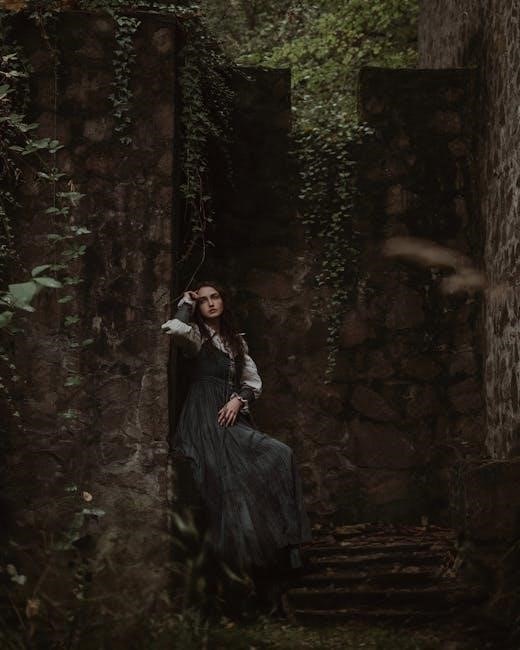Take Ivy PDF: An Overview
The “Take Ivy PDF” offers a digital glimpse into a seminal work documenting Ivy League fashion․ This guide captures the essence of classic American style through candid photographs․ It showcases collegiate apparel, providing a unique perspective on mid-century fashion trends and sartorial choices․

The Significance of “Take Ivy”
“Take Ivy” holds immense significance as a cultural document capturing a specific moment in American fashion history․ Published in 1965, it immortalized the Ivy League style, characterized by its preppy and understated elegance․ The book’s impact extends far beyond mere fashion; it represents a lifestyle and a set of values associated with elite American universities․
The photographs in “Take Ivy” offer an authentic glimpse into the wardrobes and attitudes of Ivy League students during that era․ This book wasn’t styled; it was a raw observation of people in their natural setting․ The book’s popularity in Japan contributed significantly to the global spread of Ivy League fashion, influencing designers and consumers alike․
The book’s influence can still be seen in modern menswear, with elements of the Ivy League look continually resurfacing in contemporary collections․ “Take Ivy” serves as a timeless reference point for those seeking to understand the roots of classic American style․ Its significance lies in its ability to capture a specific cultural phenomenon and its lasting impact on global fashion trends․
Ultimately, “Take Ivy” is more than just a fashion book; it’s a study of a subculture and its enduring influence on the world of style․

Historical Context of Ivy League Style
The Ivy League style emerged in the early to mid-20th century, rooted in the traditions and aesthetics of prestigious Northeastern universities․ It evolved from the practical clothing worn by students engaging in sports and outdoor activities․ This style was then refined, becoming a symbol of social status and intellectual pursuit․
Originally, Ivy League fashion emphasized practicality and comfort, with durable fabrics and classic designs․ As the style gained popularity, it transcended its utilitarian origins․ It transformed into a distinct aesthetic characterized by tailored blazers, Oxford shirts, and chinos․ These garments reflected a sense of understated elegance and a commitment to tradition․
The post-World War II era saw the Ivy League style further solidify its position in American fashion․ The economic boom and the rise of consumer culture contributed to its widespread adoption․ This style became synonymous with upward mobility and academic achievement․
The influence of Hollywood and popular media also played a significant role in shaping the perception of Ivy League fashion․ Actors and celebrities often sported these garments, further popularizing the style among the masses․ The historical context of Ivy League style is intertwined with the social, economic, and cultural shifts of the 20th century, making it a fascinating subject of study․

“Take Ivy” as a Photographic Study
“Take Ivy” transcends its status as a mere fashion guide, functioning as a significant photographic study of a specific subculture and era․ The book’s candid, documentary-style images offer an authentic glimpse into the lives and sartorial choices of Ivy League students in the mid-1960s․ These photographs capture the essence of the Ivy League look with an unvarnished realism․ They provide a valuable resource for understanding the nuances of this iconic style․
The photographers’ approach prioritized capturing genuine moments and everyday scenes․ This resulted in a collection of images that feel spontaneous and unposed․ The images are not staged studio shots, but rather snapshots of students going about their daily routines․ This authenticity is crucial to the book’s enduring appeal and historical significance․
Through careful composition and attention to detail, the photographs in “Take Ivy” document not only the clothing but also the atmosphere and environment of Ivy League campuses․ They portray the architecture, the social interactions, and the overall ambiance of these institutions․ This creates a rich tapestry of visual information that extends beyond the realm of fashion․
As a photographic study, “Take Ivy” offers a unique perspective on a specific moment in time, capturing the spirit and style of a generation․ Its influence on fashion and visual culture continues to be felt today․
Key Elements of the Ivy League Look in “Take Ivy”
“Take Ivy” meticulously showcases the defining elements of the Ivy League style․ These include a blend of classic, preppy, and understated garments, forming a cohesive and instantly recognizable aesthetic․ The key elements revolve around a commitment to quality, comfort, and timelessness, prioritizing practicality and elegance above fleeting trends․
One prominent feature is the prevalence of natural fabrics such as cotton, wool, and linen․ These materials offer breathability and durability, reflecting a preference for clothing that can withstand the rigors of daily life․ The color palette leans towards muted tones, including navy, khaki, gray, and olive green, creating a sense of understated sophistication․
Layering plays a crucial role in the Ivy League look․ This includes incorporating items such as button-down shirts, crewneck sweaters, and sport coats․ These pieces are often combined to create versatile outfits suitable for various occasions․ Attention to detail is also paramount, with accessories such as penny loafers, argyle socks, and club ties adding a touch of personality․
The emphasis is on well-fitting garments that flatter the wearer’s physique without being overly tight or revealing․ This is achieved through careful tailoring and a focus on classic silhouettes․ These elements contribute to the enduring appeal and influence of the Ivy League style․
Clothing Staples Featured in the Book
“Take Ivy” meticulously catalogs essential clothing staples that define the Ivy League look․ These garments embody a blend of functionality, comfort, and timeless elegance, reflecting the sartorial preferences of students from prestigious universities․ The book highlights pieces that are both practical for everyday wear and representative of a specific cultural aesthetic․
Button-down Oxford shirts are a cornerstone of the Ivy League wardrobe, often featuring a characteristic roll to the collar․ Paired with these shirts are classic crewneck sweaters, frequently in solid colors or subtle patterns like cable knit․ Sport coats, typically in tweed or navy blazer styles, add a layer of sophistication suitable for both casual and semi-formal settings․
Trousers in khaki or corduroy are another essential element, providing a comfortable and versatile base for various outfits․ Chinos, known for their lightweight cotton twill fabric, are also frequently featured․ Footwear options include penny loafers, saddle shoes, and boat shoes, each contributing to the relaxed yet refined atmosphere․
Accessories play a crucial role in completing the Ivy League ensemble․ Club ties, often adorned with subtle patterns or university crests, add a touch of personality․ Argyle socks, worn with loafers or dress shoes, showcase attention to detail․ These clothing staples come together to create a cohesive and enduring style․
The PDF Version and Accessibility
The availability of “Take Ivy” in PDF format significantly enhances its accessibility for a wider audience․ Digital versions allow enthusiasts and researchers to explore the book’s content without the constraints of physical copies․ This digital format ensures that the visual and textual elements are preserved, providing an authentic experience․
PDF versions often include features like searchable text, making it easier to locate specific details or keywords․ This is particularly useful for those studying the book for academic or professional purposes․ Digital accessibility also means that individuals can access the book from various devices, including computers, tablets, and smartphones, promoting convenient engagement․
Furthermore, the PDF format allows for easy sharing and distribution, fostering a community of interest around “Take Ivy․” Digital copies can be readily disseminated among fashion historians, designers, and students, ensuring that the book’s influence continues to grow․ The digital format also mitigates concerns about the preservation of older physical copies, ensuring its content remains available for future generations․
The accessibility of the PDF version democratizes access to this iconic documentation of Ivy League fashion, enabling more people to appreciate and learn from its historical and cultural significance․ This digital format ensures that “Take Ivy” remains a relevant and influential resource․
Availability and Where to Find It
Finding the “Take Ivy” PDF can involve several avenues, both official and unofficial․ Authorized digital copies are sometimes available through reputable online booksellers or academic databases that specialize in fashion history and cultural studies․ These sources often provide high-quality scans, ensuring the integrity of the original photographs and text․
However, due to copyright restrictions, locating a free, legal PDF version can be challenging․ Many unofficial copies circulate online through file-sharing platforms or blogs, but these may infringe on copyright laws and could potentially contain compromised files․ Proceed with caution when considering such sources․
Libraries and educational institutions may also offer access to the “Take Ivy” PDF through their digital collections․ Check with university libraries or archives that focus on fashion, design, or American cultural history․ Interlibrary loan programs could also facilitate access if your local library doesn’t directly hold the PDF․
Additionally, keep an eye on online forums and communities dedicated to vintage fashion or Ivy League style․ Members might share information about legitimate sources for the PDF․ Always prioritize legal and ethical acquisition methods to respect copyright and support the preservation of this iconic work․ Remember to verify the source before downloading․
Influence on Modern Fashion
“Take Ivy” has exerted a profound and lasting influence on modern fashion, particularly in menswear․ The book’s detailed documentation of Ivy League style has served as a blueprint for designers and fashion enthusiasts alike, shaping trends for decades․ Its impact is evident in the resurgence of classic American aesthetics in contemporary collections․
The book’s emphasis on timeless pieces like Oxford shirts, tweed jackets, and chinos continues to resonate with designers seeking to create enduring and versatile garments․ The preppy look, characterized by clean lines, natural fabrics, and a sense of understated elegance, owes much to the visual vocabulary established in “Take Ivy․”
Furthermore, the book’s influence extends beyond specific garments to encompass a broader philosophy of dressing․ “Take Ivy” promotes a relaxed, confident, and individualistic approach to style, encouraging wearers to embrace comfort and authenticity․ This ethos has been embraced by many contemporary designers who prioritize wearability and self-expression․
Japanese designers, in particular, have drawn significant inspiration from “Take Ivy,” incorporating elements of Ivy League style into their own unique creations․ This cross-cultural exchange has further amplified the book’s global influence․ The enduring appeal of “Take Ivy” lies in its ability to capture a moment in time while remaining relevant to evolving fashion trends․
Criticisms and Controversies Surrounding “Take Ivy”
Criticisms and Controversies Surrounding “Take Ivy”
While celebrated for its influence, “Take Ivy” has faced criticisms and sparked controversies․ Some argue that the book presents a narrow and idealized view of Ivy League culture, overlooking issues of race, class, and social exclusion․ The predominantly white, male representation in the photographs has been a point of contention, raising questions about inclusivity and representation․
Critics also point out that the book’s focus on material possessions reinforces consumerism and superficiality․ The emphasis on specific brands and clothing items can be seen as promoting a materialistic lifestyle, which some find problematic․ Furthermore, the book’s portrayal of Ivy League students as effortlessly stylish may be unrealistic and unattainable for many․
Another area of debate revolves around the book’s historical accuracy․ Some argue that “Take Ivy” romanticizes the past, glossing over the complexities and contradictions of the 1960s․ The book’s selective presentation of Ivy League life may not fully reflect the diverse experiences of students during that era․
Despite these criticisms, “Take Ivy” remains a significant cultural artifact․ Its enduring appeal lies in its ability to capture a specific moment in time and its influence on fashion and style․ However, it’s important to approach the book with a critical eye, acknowledging its limitations and biases․
Impact on Japanese Fashion

Impact on Japanese Fashion
“Take Ivy” had a profound and lasting impact on Japanese fashion․ The book’s introduction of classic American Ivy League style resonated deeply with Japanese designers and consumers, leading to the widespread adoption of preppy aesthetics․ The clean lines, tailored silhouettes, and emphasis on quality materials appealed to a Japanese sensibility that valued both tradition and modernity․
Japanese fashion magazines and retailers embraced the Ivy League look, featuring articles and advertisements showcasing the latest trends․ Brands like Brooks Brothers and J․ Press became highly sought after in Japan, symbolizing sophistication and status․ Japanese designers also began incorporating elements of Ivy League style into their own creations, blending American influences with Japanese craftsmanship․
The influence of “Take Ivy” can be seen in the popularity of items such as Oxford shirts, chinos, blazers, and penny loafers in Japan․ These wardrobe staples became synonymous with a polished and preppy look, embraced by both men and women․ The book also inspired a renewed interest in traditional American tailoring, with Japanese tailors mastering the art of creating impeccably fitted garments․
Today, the legacy of “Take Ivy” continues to shape Japanese fashion․ The enduring appeal of Ivy League style is evident in the prevalence of preppy aesthetics in contemporary collections and the continued popularity of classic American brands․ The book serves as a reminder of the power of cultural exchange and the enduring influence of American fashion on the global stage․
